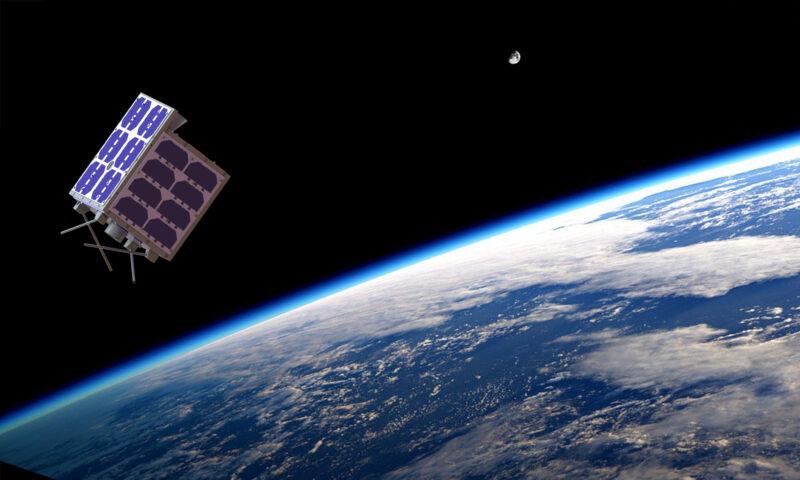
Want to work Leo satellites with your amateur radio? You might be thinking, that sounds complicated. You might not have the room or the funds for an antenna array. Unless you want to do EME, I believe I’ve found a reasonable compromise between cost/performance with my current configuration. The CLP‑5130‑2N log periodic.
A fixed‑elevation log‑periodic setup like the Create CLP‑5130‑2N offers a compelling blend of cost savings, simplicity, and wide-band performance for satellite work—especially when you compare it to a full azimuth/elevation rotator system driving two separate yagi antennas. Below is an exploration of the key cost‑benefit areas and a performance comparison with typical single‑band yagi designs.

1. Fixed Elevation: Reducing Mechanical Complexity and Cost
Traditional satellite stations use a dual‑axis rotator (azimuth + elevation) to track passes, which typically costs around $750–$800 for the rotator alone (e.g., Yaesu G‑5500DC at $759.95) GigaParts. On top of that, you need control cables, mast adapters, and a controller unit—easily adding another $200–$300 in hardware and installation. In contrast, a fixed‑elevation approach mounts the antenna at a compromise elevation angle (often 30°–45°), eliminating the elevation rotator, its controller, and associated wiring. I’ve found at my location, and antenna height, accounting for nearby structures and my view of the horizon, that 22 degrees seems to be my sweet spot. You end up with just a simple mast bracket (under $50) or, at most, a manual elevation adjustment bracket—saving roughly $1,000 in up‑front costs.
2. One Antenna vs. Two: Capital and Installation Savings
The Create CLP‑5130‑2N is a wideband log‑periodic covering 105 – 1300 MHz with 11–13 dBi of forward gain and an SWR under 2:1 across its entire range DX Engineering. Its N‑female connector and 4.83 ft boom make it straightforward to mount. At $379.99, it undercuts the combined cost of two comparable single‑band yagis. For example:
- 2 m Yagi: Cushcraft A148‑10S (10 elements) offers 13.2 dBi gain, a 40° E‑plane beamwidth, and a 24 dB front‑to‑back ratio for $326.00 GPS CentralDX Engineering.
- 70 cm Yagi: Cushcraft A44911S (11 elements) provides about 13.4 dBi gain over 440 – 450 MHz on a 4.2 ft boom for $179.95 DX EngineeringDX Engineering.
Together, those two yagis total $505.95 plus the cost of a shared or separate azimuth rotator (~$300+), whereas the single CLP‑5130‑2N at $379.99 needs only one azimuth rotator (if any), trimming another $200–$300. Of course, you could run a dual band Yagi. Most likely with lower gain on each band. Then there’s the issue of beamwidth, continue on my friend.
3. Performance Trade‑Offs: Beamwidth and Gain
- Gain: The CLP‑5130‑2N’s 11–13 dBi is on par with an 11‑element 2 m yagi (13.2 dBi) and an 11‑element 70 cm yagi (13.4 dBi) DX EngineeringDX Engineering.
- Beamwidth: Log‑periodics have broader half‑power beamwidths (~60°) versus yagis’ ~40° (2 m) and ~30° (70 cm). This broad pattern means a fixed‑elevation log‑periodic can “see” a larger swath of the sky without continual elevation adjustment—a useful compromise for many LEO passes.
- Front‑to‑Back: Yagis often achieve 24 dB F/B, compared to ~15 dB for the CLP‑5130‑2N. If rejection of ground or off‑axis signals is critical, a yagi might be preferred; however, for many satellite contacts, the additional simplicity of the log‑periodic outweighs this.
4. Total Cost of Ownership and Maintenance
- Clutter and Weight: One log‑periodic (11 lbs) is lighter and less imposing on a mast than two yagis plus their mounting booms.
- Maintenance: Fewer moving parts (no elevation rotor, fewer boom joints) means less to service and lower chance of failure, reducing long‑term maintenance costs.
- Installation Time: A single antenna and single‑axis (or no) rotator simplifies cabling and alignment—cutting labor and complexity by 30–50%.
5. When You Might Choose a Yagi + Az/El Rotator
If maximum gain per band, tight beam control, and steep elevation tracking are paramount—such as for very low‑power or EME operations—the higher initial outlay (~$1,200–$1,500) for two optimized yagis and a dual‑axis rotator can be justified. Yet for standard LEO satellite work with modest EIRP requirements, the fixed‑elevation log‑periodic offers near‑equivalent performance at about half the cost.
Conclusion
Running a fixed‑elevation Create CLP‑5130‑2N log‑periodic for satellite operations balances performance, convenience, and cost. You pay roughly $380 for a true wideband beam, saving $150–$300 versus two separate yagis, and save an additional $750 by skipping an elevation rotator DX EngineeringGigaParts. The result is a leaner budget (often under $700 total), faster installation, and simpler upkeep, all while maintaining gain and coverage broadly comparable to traditional dual‑yagi, dual‑axis setups. For many hams, that makes the CLP‑5130‑2N fixed‑elevation package an unbeatable value. Of course, you’ll want to use quality coax. I used Messi & Paoloni Ultraflex 10 https://messi.it/NF/SchedaProdotto.aspx?l=IT&s=3&nf=MEP-FLEX50BP100 with N type connectors.
